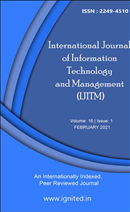The Influence of Social Media Marketing on Consumers Behavior
Main Article Content
Authors
Abstract
Social media advertising's perceived utility, simplicity of use, entertainment, intrusiveness, andfrequency of use have been determined to be the most important elements influencing consumers'attitudes toward social media advertising, according to a new study. Customers' attitudes about socialmedia advertising are influenced by their perceptions of how easy it is to use. Consumers' attitudes towardsocial media advertising are influenced by factors such as perceived utility and intensity of social mediause, business reputation and incentives, perceived ad entertainment, perceived commercial intrusion, andpeer influence. Consumers' behavior regarding social media advertising, their intention to engage in eWOMbehaviors, their intention to visit the websites of firms, and their purchase intents were shown to haveno significant moderating influence on each other.
Downloads
Download data is not yet available.
Article Details
Section
Articles
References
- Hansen, T, Møller Jensen, J. M., &Solgaard, H. S. (2004). Predicting online grocery buying intention: A comparison of the theory of reasoned action and the theory of planned behavior. International Journal of Information Management, 24 (6), 539- 550. doi:10.1016/j.ijinfomgt.2004.08.004
- Ridings, C. M., & Gefen, D. (2004). Virtual community attraction: why people hang out online. Journal of Computer-Mediated Communication, 10 (1), 1-10. doi:10.1111/j.1083-6101.2004.tb00229.x
- Chang, M. K., Cheung, W., & Lai, V. S. (2005). Literature derived reference models for the adoption of online shopping. Information Management, 42 (4), 543- 559. doi:10.1016/j.im.2004.02.006
- Engel, J. E., Blackwell, R. D., & Miniard, P.W. (2006). Consumer Behaviour, 10th ed., Harcourt Brace Jovanovich, New York, NY.
- Liu, Y. (2006). Word of mouth for movies: its dynamics and impact on box office revenue. Journal of Marketing, 70 (3), 74-89. doi:10.1509/jmkg.70.3.074
- Armstrong, G., & Kotler, P. (2007). Marketing: An Introduction. Upper Saddle River, N.J: Pearson Prentice Hall.
- Bruyn, A. D., & Lilien, G. L. (2008). A multi-stage model of word-of-mouth influence through viral marketing. International Journal of Research in Marketing, 25 (3), 151-163. doi: 10.1016/j.ijresmar.2008.03.004
- Davis, A., & Khazanchi, D. (2008). An empirical study of online word of mouth as a predictor for multi-product category e-commerce sales. Electronic Markets, 18 (2), 130-141. doi:10.1080/10196780802044776
- Seock, Y., & Bailey, L. R. (2008). The influence of college students' shopping orientations and gender differences on online information searches and purchase behaviours. International Journal of Consumer Studies, 32 (2), 113-121. doi: 10.1111/j.1470-6431.2007.00647.x
- Wu, S. I., Wei, P. L., & Chen, J. H. (2008). Influential factors and relational structure of internet banner advertising in the tourism industry. Tourism Management, 29 (1), 221-236. doi:10.1016/j.tourman.2007.03.020
- Iyengar, R. and Han, S., & Gupta, S. (2009). Do Friends Influence Purchases in a Social Network? Harvard Business School Marketing Unit Working Paper No. pp. 09-123. doi:10.2139/ssrn.1392172
- Mangold, W. G., & Faulds, D. J. (2009). Social media: The new hybrid element for promotion mix. Business Horizons, 52 (4), 357-365.
- Berger, J., Sorensen, A. T., & Rasmussen, S. J. (2010). Positive effects of negative publicity: When negative reviews increase sales. Marketing Science, 29 (5), 815- 827. doi:10.1287/mksc.1090.0557
- Tham, A., Croy, G., & Mair, J. (2013). Social media in destination choice: distinctive electronic word-of-mouth dimensions. Journal of Travel & Tourism Marketing, 30 (1-2), 144-155. doi:10.1080/10548408.2013.751272
- Schivinski, B., & Dabrowski, D. (2016). The effect of social media communication on consumer perception of brands. Journal of Marketing Communications, 22 (2), 189-214. doi:10.1080/13527266.2013.871323
- Stojanovic, I., Andreu, L., & Curras-Perez, R. (2018). Effects of the intensity of use of social media on brand equity: An empirical study in a tourist destination. European Journal of Management and Business Economics, 27 (1), 83-100. doi:10.1108/EJMBE-11-2017-0049

